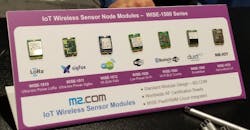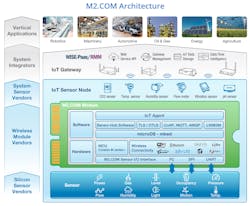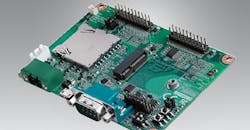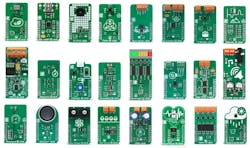Delivering nodes for the Internet of Things (IoT) can be challenging given the number of protocols, interfaces, and stacks involved. Often a sensor suite needs to be deployed using different combinations of connectivity options. Sometimes the number of devices is very large, making custom designs desirable given the ability to reduce cost and size. On the other hand, many systems are less numerous, so a more modular approach makes more sense.
1. The M.2 form factor has been adopted by the M2.COM. It supports multiple low-speed serial interfaces such as SPI and I2C, as well as GPIO and ADC.
Though the M.2 form factor typically performs storage duties, M2.COM is using it for the IoT. M2.COM combines sensors, networking, and control into a single compact form factor (Fig. 1). The standard module is 30- × 22 mm; there’s also a longer 30- × 42-mm version. It exposes low-speed interfaces such as USB, SDIO, I²C, I²S, UART, and SPI, as well as peripheral interfaces including GPIO, PWM, and ADC on the M.2’s 75-pin socket.
Advantech is one company that’s providing a range of M2.COM modules (Fig. 2). These feature Arm Cortex-based microcontrollers and wireless communication support. Also included are standard IoT wireless links such as NB-IoT, Dust, Bluetooth, Wi-Fi, WISE, Sigfox, and LoRa. Furthermore, modules are integrated with the WISE-PaaS/RMM cloud service.
2. Advantech is providing a range of M2.COM wireless modules.
The M2.COM architecture is built around Arm’s mbed microOS running on a microcontroller (Fig. 3). Typically, the module will also maintain wireless communication support. A baseboard would incorporate any peripherals and connectors that the module could query and control. In theory, the M2.COM module could be selected based on the required wireless interface. Therefore, the same platform could be used for a LoRaWAN device or cellular modem by just plugging in the appropriate M2.COM module.
3. The M2.COM architecture targets the wireless Internet of Things.
The form factor isn’t limited to mbed support, but this software stack provides a standard platform to be utilized. The microOS already supports secure communication with TLS and DTLS, as well as support for IoT communication protocols common in this space such as CoAP, MQTT, and AMQP.
Advantech is on board, so to speak, with M2.COM, and provides the WISE-DB1500 development board (Fig. 4). It exposes the UART and USB interfaces with matching sockets. Two headers expose other interfaces including I2C, I2S, GPIO, PWM and ADC channels. There’s an on-board humidity and temperature sensor as well as an SD card slot that uses the SDIO interface.
4. Advantech’s WISE-DB1500 development board has a single M2.COM socket that exposes interfaces for easy access.
It would be interesting to have an M2.COM carrier board that also has a MikroElektronika Click Board socket. The interfaces on one of these boards includes SPI, I2C, UART, PWM, and an analog pin. Hundreds of Click Boards are available from a number of vendors (Fig. 5). They’re also easy to design.
5. MikroElektronika Click Boards might be a good match for M2.COM modules, given the similarity in interfaces.
Another expansion option could be Mini-PCI Express modules. This form factor does have PCI Express support, but many of the peripheral modules instead utilize the USB or I2C interfaces also found on the socket.
M2.COM works well for modular system design as well as prototyping. Migrating to a completely custom board after a prototype proves the viability of a system is a relatively easy process.







